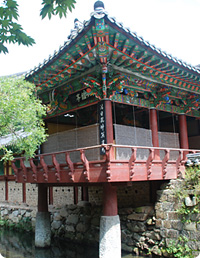PACKAGE
Glory of Baekje 6 days
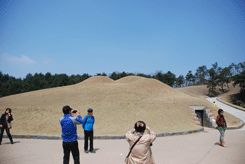
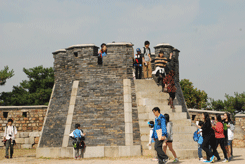
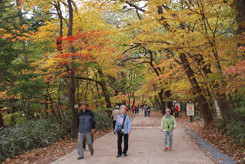
Tour Highlights
- Gyeongbokgung Palace
- National Folk Museum of Korea
- Insadong
- Gwangjang Market
- N Seoul Tower
- Hwaseong Fortress
- Solmoe Holy Ground
- Haemi Fortress
- Sudeoksa Temple
- Oeammaeul Village
- Onyang Folklore Museum
- Hyeonchungsa Shrine
- Gongju National Museum
- Songsanri Tomb
- Gungnamji Pond
- Jeongrimsa Pagoda
- Buyeo National Museum
- Busosan Fortress
- Baekje Culture Complex
- Gwanchoksa Temple
- Jeonju Hanok Village
- Geumsansa Temple
- Mireuksa Temple Site
- Wanggunri Palace Site
Click on the days to access the program quick
| Days | Visits and Activities | Distance |
| Day 1 | Arrive Seoul | 60km |
| Day 2 | Seoul | |
| Day 3 | Seoul - Suwon - Dangjin - Haemi - Yesan - Asan | 220km |
| Day 4 | Asan - Gongju - Buyeo - Nonsan - Jeonju | 160km |
| Day 5 | Jeonju - Gimje - Iksan - Seoul | 250km |
| Day 6 | Departure | 60km |
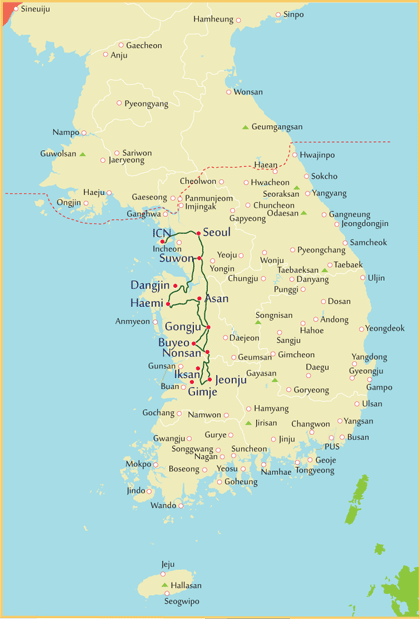 Day 1 Arrive Seoul (- - -)
Day 1 Arrive Seoul (- - -)
60km
Touching down at Incheon International Airport places you in the heart of Korea. After you clear Passport and Customs control, you will be welcomed by the tour guide and then transferred to your hotel.
Day 2 Seoul (B)
Your exploration this morning begins with a driving tour of Seoul, featuring sites such as Seoul Plaza, City Hall, Cheonggye Square and pedestrian-friendly Gwanghwamun Plaza that is hemmed in on three sides by rushing traffic. The plaza is lined on each side with 365m long streamlets, two centimeters deep and one meter across, the stone bed of the plaza's east side waterway engraved with important events in chronological order from 1392 to 2008.
Standing high on a stone pillar is a statue of Yi Sunsin who had engaged in twenty-three naval battles and emerged victorious in all of them during the Hideyoshi invasion (1592-1598). King Sejong who propagated the Korean alphabet in the 15th century is also honored with prominent statue. On August 16, 2014, Pope Francis celebrated Mass in this plaza to beatify 124 Korean martyrs. Near the southwest corner of the plaza is Korea's Kilometer Zero, marking the distances to 64 cities around the world, including Seoul's antipode, Montevideo, Uruguay, 19,606km.
Step back in time to when life was gracefully slow and discover Gyeongbokgung Palace, a particularly charming spot that represents a colorful and turbulent side of the capital's 500-year history. Depending on timing, you may witness the Royal Guard Changing Ceremony featuring parade, password verification, duty shift and patrolling the gate. Accompanied by a court band with its colorful costumes and royal flags, the ceremony is performed daily basis at 10:00 and 14:00 except Tuesdays, although it is cancelled in case of rain or extremely hot or cold weather.
Up from the gates is a spacious stone-paved courtyard that is fully enclosed by wooden cloisters, and at the center of which runs three footpaths through two rows of rank stones, indicating the positions of the officials with the highest rank being closer to the hall.
Standing majestically on top of a two-tiered stone platform that is lined with detailed balustrades is Geunjeongjeon Hall, where the king formally granted audiences to his officials, gave declarations of national importance, presided over large official functions, and greeted foreign envoys and ambassadors. Check out the royal throne and a large painting, depicting sun, moon, five peaks, streams and pine trees, which was the crucial signifier of the king. And up in the center of the ceiling, the bright golden dragons in bold relief indicate the presence of the king.
At the back of the throne hall is a group of court offices. Displayed in front of the King's official quarters is sundial, conceived in order to catch the shadow of the sun, which tells time and 24 periods of seasonal change from the winter solstice to the summer solstice.
Sitting on the island in the rectangular lake is Gyeonghoeru. Supported by 48 square and cylindrical massive stone pillars representing the idea of Yin and Yang, this magnificent pavilion was used for many purposes ranging from receptions to national examinations.
Gangnyeongjeon is the king's sleeping and living quarters while Gyotaejeon is the queen's domain containing a number of halls. The noted feature of these main buildings is an absence of a top roof ridge.
Amisan Garden, landscaped with four hexagonal chimneys in orange bricks, is seldom noticed by the hurried visitors. Jagyeongjeon is the queen dowager's residence. Although less colorful, it is worth noting the wall, adorned with floral designs and the chimneys with ten longevity symbols.
Hyangwonjeong features a small pond with a manmade islet that supports a beautiful two-story pavilion. Behind this serene garden is Geoncheonggung, where the king and queen could relax in peace and quiet. It was here that the first electric lights in the country were installed in 1887 after 8 years of Thomas Edison's invention and a tragic chapter in Korea's history was recorded when empress Myeongseong was assassinated by the sword-bearing Japanese assassins in the early morning of 8 October 1895, allegedly under orders from Miura Goro.
Your visit to the National Folk Museum of Korea will familiarize you with wealthy culture of this friendly and picturesque nation. It is an excellent facility to illustrate the history of traditional life of the Korean people from the prehistoric age to the Joseon dynasty. The permanent exhibition features life and work, costumes and ornaments, handicrafts and technology, educations, living quarters, dietary life, oriental medicine, performing arts and games, beliefs and rituals, and
socio cultural life.
Insadong, at one time the center of traditional Korean art and antiques, features a mixture of historical and modern atmosphere representing the cultural glimpse of the nation. Clustered along the main street and alleys are lined with street vendors, wooden tea houses, restaurants and numerous galleries and shops dealing in antiques, oriental art supplies, and modern Korean art of all types and styles. Soak in the paintings, upscale artworks, antiques and potteries while you can. Get lucky and you just might meet the artist themselves. It can be plenty of fun walking on the main street, but you venture into the hidden alleys that do spring some unexpected surprises. While here, you may want to buy some souvenirs or simply wander and browse at leisure admiring cultural ambience.
Enjoy a brief visit to Gwangjang market. It is one of few markets retaining traditional Korean atmosphere. Established in 1905, the market today has 5,000 independent shops. On the market's ground level, the floor space is dominated by scores of small snack stalls selling rustic delicacies and cheap treats. Clouds of smoke billow out from the boiling pans, diverse types of pancakes sizzle on hot iron grills and the smell from the eateries filling the air. The roadside vendors hawking everything from food, fruits, vegetables to seafood and an entire upper level dedicated to high quality silk, satin, and linen. Try out some sorts of Korean snacks and see a side of regular Seoul life.
Drive past Cheonggyecheon Stream. After the Korean War (1950-1953), more people migrated into Seoul to make their living and settled down along the stream in shabby makeshift houses. The accompanying trash and waste, and deteriorating conditions resulted in an eyesore for the city. The stream was covered with layers of concrete in the mid 1950s and roadway until the massive urban renewal project freed it in 2005. Today, a 5.8km creek tumbles gently through downtown Seoul, providing a much needed source of peace and relaxation for the citizens of this fast-paced city. You may have a chance to view the sculpture standing tall at the head of the stream on a small plaza. Created by Dutch artist Coosje Van Bruggen and Swedish artist Claes Oldenburg, a shell rising upward like pagoda symbolizes new life.
You will also view Dongdaemun which once served as the east gate of Seoul and a block away is DDP of a distinctively neofuturistic design. Characterized by the "powerful, curving forms of elongated structures", it ramains as a major urban development landmark of Seoul.
Before you end the day's sightseeing, you will enjoy a panoramic view of Seoul over at N Seoul Tower observatory. Perched on top of Namsan Mountain, the tower tops out at 479.7m above sea level. It was constructed in 1975 as Korea's first integrated communication tower, transmitting TV and FM radio signals to the city and has now become a symbolic landmark of the capital. It is the absolute best place to enjoy the most enthralling vistas of Seoul. Near the tower base, you cannot possibly miss time capsule. Buried in 1985 under 15m of the ground, it holds 466 relics representing contemporary Korean lifestyle and culture. The capsule is scheduled to open five hundred years later in 2485. You will also witness thousands of Love Padlocks hanging from all sides, overwhelming the wire fence, without their keys to symbolize that their love for each other is forever. And Love Trees made of hundreds of locks are quite a sight to behold.
Day 3 Seoul - Suwon - Dangjin - Haemi - Yesan - Asan (B) 220km
Travel to Suwon to explore UNESCO World Heritage site of Hwaseong Fortress from the 18th century. Though the fortress is relatively small in scale, it is well acknowledged as the best structure of its kind ever built in Korea. A 5.74km-long fortress enclosing both flatland and hilly terrain is parapeted with crenels and merlons and highlighted by four main gates and well over 50 structures including temporary palace where the king sought refuge during war and found rest during times of peace. A walk through the whole fortress could take several hours but it is well worth making a short walking tour to enjoy the splendor of the fortress, including the Korea's largest Janganmun Gate.
Solmoe holy ground is the birthplace of St. Andrew Kim Dae-geon (1821-1846), who was the first Korean Catholic priest, and where the Catholic religion took root in Korea. Four generations of the Kim family, all of whom were martyred, were born and lived here. The Path of the Cross features a mosaic path showing the hands of Jesus and a bronze path on a large scale. A walk up the pine tree road leads to a bronze statue of the priest holding a bible in his left hand and delivering the message of the Gospel. Nearby is the Path of the Cross, symbolizing the path of the ordeal that Jesus had to walk carrying a cross to his crucifixion as detailed in the Christian Bible.
The Solmoe Holy Ground memorial hall has on display various documents on the life of Priest Kim Dae-geon, detailing the persecution of members of the Korean Catholic Church, and letters and reports on martyrs written by the priest. The Path of the Cross features a mosaic path showing the hands of Jesus and a bronze path on a large scale. This is where many Catholic pilgrims pray or meditate while walking among pine trees. This Holy Ground is of major significance as one of the sites Pope Francis visited during his official visit to Korea. The papal trip is all the more momentous as it is his first visit to Asia and he will only be visiting Korea.
Visit Haemi Fortress and learn about the holy place for the Catholics. Haemi has been the military base since the construction of fortress in 1491. The fortress has an oval shape and measures 5m high and 1,810m long. Architecture aside, Haemi Fortress's historical importance is closely tied with the history of the Catholic Church in Korea. It was here that many Catholics were executed during the Byeongin Persecution of 1866, and the fortress and its surroundings are considered holy ground by Korean Catholics. The memorial is dedicated to those who martyred here. The rock to the right of the memorial is particularly macabre - some of the victims were executed by ramming their heads repeatedly into the stone. Near the fortress is Yeosutgol holy site, where Catholics were buried alive, drowned and otherwise made dead en masse. The pope Francis visited the Haemi Martyrdom Holy Ground and the Haemi Fortress to meet with Asian bishops and closing mass for Asian Youth Day on August 17, 2014 during his five days trip to Korea.
While in Yesan, visit Sudeoksa temple. The temple is rather unremarkable, laid out along a more-or-less central axis with the standard entry sequence of multiple gates placed on land that slopes up toward the main courtyard. The main worship hall is an original structure built in 1308, thought to be one of the oldest wooden buildings in the country. Another piece of architecture worthy of note is the 14th century stone pagoda standing in the main courtyard. It is a beautifully-balanced Goryeo period pagoda, an elegant 4.1 meter-high 3 storied stone pagoda.
Next, explore Oeammaeul village. It is one of the traditional clan villages exuding old and rustic charm. The village entrance is marked by stone bridge, pine forest and totem poles. This village with more than 400 years of history has about 70 traditional houses, and is highlighted by 6km-long stonewall paths ringing the village and the amazing artificial water system that goes through the entire village for gardens and agriculture. As you stroll along the pathway, you will see thatched cottages and tile roof houses representing typical village layout of central Korea and at the same time feel the rural ambience and peaceful atmosphere.
Onyang folklore museum features traditional livelihood, industry, culture, folk paintings and artworks. The museum exhibits a vast array of beautiful and priceless antiques that speak to the life and traditions of the Korean people.
While here, you will also visit Hyeonchungsa dedicated to the Korea's greatest naval hero, Admiral Yi Sunsin. This shrine keeps the spirit of Yi Sun-sin. The complex features the house where the admiral grew up, an archery range where he practiced, a museum containing a pictorial story of his life and an example of his famous turtle ship. The museum also contains his war diary and sword he carried.
Day 4 Asan - Gongju - Buyeo - Nonsan - Jeonju (B) 160km
Gongju is a charming city that once served as the Baekje's capital for 63 years from 475 to 538. Visit Gongju National Museum and get a glimpse of the fascinating archaeological articles from Baekje era, and artifacts excavated from the royal tomb of King Muryeong (501-524), one of the last rulers to reign in the capital of Gongju.
Near museum is UNESCO Heritage site of Songsanri Tombs, a group of royal tombs that just look like a cluster of grassy knolls. The tomb which belongs to King Muryeong (462-523) and his wife, the queen was found completely intact since it was sealed in the early 6th century. The actual tomb was permanently closed, but you will see an excellent, albeit miniature duplicate.
Buyeo is a melting pot of Baekje culture which is often regarded as the most artistically sophisticated of the Three Kingdoms. Today, you will explore archaeological sites and ancient historic areas, which were collectively named as a UNESCO World Heritage sites. Gungnamji is the Korea's oldest artificial pond dating back to 634. Ringed by weeping willow trees, it creates a colorful spectacle with its stock of water lotuses in summer. Jeongrimsa temple site with its five-storied stone pagoda recalling the glorious past is one of the city's most distinctive and outstanding landmarks.
At Buyeo National Museum, you will feel the spirit and the essence of the brilliant Baekje culture as you appreciate the beauty of the archaeological relics. A beautiful gilt bronze incense burner is impossible to miss. Crafted over 1,500 years ago, it shows a graceful dignity and the elaborate skills of Baekje craftsmen.
Stroll up paths to Busosan to explore Baekje fortification. At the top of the hill sits Yeongillu pavilion where the king once came to watch the sun rise over his kingdom.
A little further down the trail, you will see a pavilion called Baekhwajeong perched at the top of the rock beside which locates Nakhwaam, literally meaning Falling Flower Rock, on a bluff overlooking the Geum River at the bend called Baekma. As enemies swarmed into the capital, the court ladies flung themselves into the water from this bluff rather than suffer the shame of submitting to atrocities of the conquering enemy armies.
Visit Baekje Culture Complex, a history theme park with its restored royal palaces of Baekje, an elegant five-story wooden stupa,
and a fascinating museum where you may observe the history and culture of the glorious kingdom.
Time permitting, stop at Gwanchoksa to see the Korea's largest free-standing stone Buddha image from the 10th century. It is an extraordinary statue with a head disproportionately large in relation to the body, and wearing a lofty mortar board hat on top of its headpiece with wind chimes hanging from its four corners. The image features seem jolly and complacent, though perhaps not so intended.
Day 5 Jeonju - Gimje - Iksan - Seoul (B) 250km
Jeonju boasts a time-honored tradition as well as significant cultural and artistic heritage. You will explore Jeonju Hankok village, a Korean House complex retaining much of their perfection intact. Near the entrance of the complex stands Gyeonggijeon that holds the portrait of founder king of Joseon dynasty, featuring him seated in a magnificent red chair with three gold-foiled dragons on his royal blue robes. And on its front is a beautiful Jeondong Catholic church of Byzantine and Romanesque architectural design. Completed in 1914, it is one of the oldest and largest Western-style buildings in the region. It was designed by master church builder Victor Lousi Poisnel, the Norman priest whose work in Korea includes Myeongdong Cathedral in Seoul. Just west of the church is the stately Pungnammun gate, where three Catholics paid for their religion with martyrdom on December 8, 1791, marking the first time in Korea.
Gimje is a home of a magnificent Geumsansa temple. It was the main temple for practicing the Maitreya faith during the Silla period. The Maitreya Buddha Hall is a three story wooden structure, a unique among Korean Buddhist halls. Enshrined in the hall is a huge Maitreya Buddha. Maitreya is refining his bodhisattva practice in Tusita but will come down to earth in the future and become a Buddha. He is attended by Dharma Flower Grove Bodhisattva on his left and Great Wonderful Aspect Bodhisattva on his right. Check out 5 story pagoda from Goryeo period standing at 7.5m near Maitreya hall. It is relatively large in size, but has a simple appearance.
While in Iksan, you will tour UNESCO Heritage sites of Mireuksa temple site with its 7th century stone pagoda and Wanggungri palace site that recalls the glory of the ancient kingdom. The temple has been a symbol of spiritual guidance and support for Baekje, and on a vast archaeological palace site, you will also witness the five-story stone pagoda standing alone.
Day 6 Departure (B) 60km
After this wonderful trip exploring Korea and with time to reflect on your surprise in your experience, you will return to the airport in time for your flight. By boarding, you are already high above Incheon heading for home.





